2009 DIGI AWARD WINNERS

Extending the Reach of Digital Signage Everywhere
As Chair of the Judges Committee for the DIGI Awards, it was an honor to personally present the trophies recognizing the winners at The Digital Signage Show in New York this past November. That group of winners — the best examples of what is new and important in digital signage deployments, best use of content, and best new products — represents not just new trends in the industry, but, more important, proof that digital signage is entering the mainstream.
The DIGI Awards recognize the resellers, integrators, and service providers who have gone the extra mile to ensure success for their clients, thereby furthering the digital signage industry as a whole. And new this year, we added New Product awards in order to recognize strides made in bring to market new tools for a growing industry.
MIELE’S INSPIRIENCE CENTRE
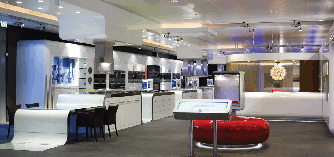
House of Media Experience for Miele Inspirience Centre
DESCRIPTION: At over 3000 m2 (32,000 ft), Miele’s Inspirience Centre, in Vianen, the Netherlands, has been carefully designed to encompass a wide range of traditional and digital events. Particular spaces are used to demonstrate products and provide relaxation areas, and multiple touchpoints to help guide visitors through their experience. The store contains a complete range of custom furniture, lighting, brand-enhancing visuals, signposting, information channels, sounds, and scents — all collaborating in a centrally managed way to provide visitors with a seamless total sense experience.
For example, there are over 100 screens of different formats and aspects providing over 40 channels of customized Miele content at full HD quality. Content is either running dynamically (triggered automatically based upon predefined rules) or is controlled by human interaction. Furthermore, the sophistication of the technology behind the experience provided Miele with the opportunity to deliver customer-specific experiences based on the customer’s unique set of preferences provided to Miele as part of their induction to the Inspirience Centre. By adding context information the experience becomes relevant, timely, and fits the customer’s expectations.
A daily selection of the top stories for AV integrators, resellers and consultants. Sign up below.
To ensure the customer experience at a Miele center is personalized and relevant, customers and dealers are requested to register before they enter the store. This could be via the web, call center, or at the Inspirience Centre. This process provides Miele basic information on the customer (gender, demographics, lifestyle, historic Miele purchases, etc.) but it also does much more. Visitor information is fed into the store’s “decision engine” by the web site or by a custommade system set up by Troades, which analyzes the data and creates a real-time message format for each visitor. The visitor can use an Apple iPod Touch that contains the visitor’s name, preferences, and profile so that visitors opt into the service and information can flow both ways, a classic permission-based marketing approach.
The store is equipped throughout with indoor GPS technology. Each visitor’s iPod Touch has a unique identifier and is equipped with a GPS transmitter that pinpoints the location of the device at any point within the store and references its location in relation to the 50 cm square floor tiles that are laid throughout the store and are also linked to the system.
RESOURCES: The functionality of the system is facilitated by Scala, which manages the coordination of the decisions made by the Miele system. This includes adjusting the lighting brightness, to scheduling the dispersal of aromas, to creation and scheduling of content for more than 100 Apple and Philips screens. Content on the screens, both dynamic and interactive, can be tailored to match a user profile, as can recommendations, tips, and advice that can be sent to the iPod Touch proactively or at the request of the visitor
PARTNERS: House of Media Experience (www.houseofmediaexperience.nl), Troades (www.hybridesignage.com), Scala (www.scala.com)
ENTRY CONTACT: Miele, www.miele.nl
LEVEL 5/HAMMOND COMMUNICATION GROUP INSTALLATION AT THE SPRINT STUDIO STORE
PURPOSE: To create a more innovative and overall more pleasing customer service experience while simultaneously impacting the branding and marketing of new products in store.
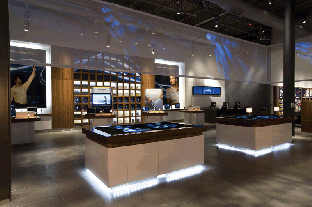
Level 5/Hammond Communication Group for Sprint Studio Store
DESCRIPTION: When visitors enter the Sprint store in Kansas City, MO, they are greeted at the concierge station where, based on need, are directed to one of five zones throughout the store. Each zone is equipped with three to five HD LCD monitors that include content relative to the customer queuing and zone specific messaging. Triggered events are scheduled to occur every hour resulting in a “Grand Moment” that begins when the digital signage system lowers the ambient light and audio in the entire store and then plays synchronized video, audio, and special effects lighting. A single message comprised of 17 HD videos and five audio sources (one for each zone) is split and synchronized on 17 displays, with each of the five zones playing audio relative to its depart of the Grand Moment.
Triggering codes for multiple thirdparty devices and applications needed to be developed for Grand Moments to occur every hour in a unique and synchronized fashion. This included creating custom triggers for BIAMP lighting servers, Muzak audio controllers, and Sprint’s custom Queue application. The digital signage display also fires 17 HD videos, within five playlists, each being between 4080 and 6800 pixels wide per zone, at precisely the same time.
Much of the magic behind the Grand Moment can be found in the custom HD transcoding, scripting, and central Content Manager configuration performed by Hammond Communication Group, the custom programming created by Scala engineers and the third-party triggering device development by Level 5 Media Group. These items allow the Content Manager to control not only the media players, but also external environmental control devices, which when used together allow for synchronized audio, video, and lighting. The visitor experiences an entire store moment unlike any in the retail environment today.
EFFECTIVENESS: In its essence, the digital signage network’s effectiveness is measured by how well it manages the flow of customers entering the store. Because a queuing system is part of the network, customers are able to receive messaging specific to the reason for their trip to the store while they wait for the next available employee.
Effectiveness is measured easily by watching the customers in store stop and watch the Grand Moment while they are browsing or engaging with store employees. With a Grand Moment taking place randomly at the top of every hour, the sudden attention paid to the digital signage network is very telling of the impact it has to consumers and employees alike.
RESOURCES: It took extensive testing to find the devices capable of firing the HD videos within multiple playlists at the exact same time. The system also required custom HD transcoding, scripting, and central configuration of Scala Content Manager software, which were completed by Hammond Communications Group. Scala engineers played a key role in helping Level 5 determine the proper hardware devices needed to operate the network. Extensive testing was required to find the proper devices that were capable of meeting the special feature of playing 17 HD videos, within 5 playlists, each being between 4080 and 6800 pixels wide per zone, at precisely the same time.
PRIMARY HARDWARE: All content is HD, so three to five HD LCD monitors are deployed in each of the five zones located throughout the store to deliver the content. Running software is Scala Content Manager.
PARTNERS: Hammond Communications Group (www.hammondcg.com), Scala Inc. (www.scala.com)
ENTRY CONTACT: Level 5 Media Group, www.level5mediagroup.com
Best Deployment: Transportation
BRITISH COLUMBIA RAPID TRANSIT COMPANY, SKYTRAIN
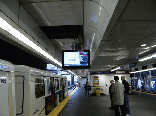
iMediaT Digital For British Columbia Rapid Transit Company, SkyTrain
PURPOSE: To inform SkyTrain Rapid Transit users of any emergency issues when they enter a station on 57-inch and dual 40-inch LCD configurations. During non-emergency times the panels display standard content that includes trivia, tips, and rider information. When an emergency occurs the standard content is overridden with dynamic emergency messaging to inform users of issues along the line before they enter a station and purchase a ticket.
The ability to override standard content with emergency messaging is key, along with the ability to target an individual screen, station, or any combination of screens with messaging via a browser interface.
EFFECTIVENESS: British Columbia Rapid Transit Company (BCRTC) is now measuring effectiveness via feedback sessions with field operations staff, who are the users of the system. Users like the ease of use and dynamic nature of the signage as it replaced a manual sandwich board system used since SkyTrain’s inception in 1983.
CHALLENGES: The main challenge was targeting and overriding standard content. British Columbia Rapid Transit was able to develop a very robust and easyto- use browser-based application that works directly with the SQL server and the PADS digital signage software from NDS. The power of PADS rules-based logic was pivotal in implementing this strategy. Also, BCRTC required that all screens send heartbeat information to be managed via the browser. We were able to develop the software to query the screens periodically and report their temperature, aspect ratio, current input, and whether they were on or off. The interface also permitted users to remotely turn a screen on or off with a button click.
PARTNERS: Best Buy Canada Commercial Services, Net Display Systems, Samsung
ENTRY CONTACT: iMediaT Digital, imediatdigital.com
CISCO FOR CISCO DIGITAL SIGNAGE SYSTEM AT DALLAS COWBOY STADIUM

Jerry Jones, owner and general manager of the Dallas Cowboys NFL Football Club, Bryan Trubey, principal designer at HKS Sports and Entertainment Group, and Pete Walsh, head of technology of the Dallas Cowboys Football Club, stand in front of a high-definition TV near the concessions area at the new Dallas Cowboys Stadium, which uses Cisco StadiumVision.
PURPOSE: The new Dallas Cowboys stadium has been outfitted with Cisco StadiumVision, a Cisco Connected Sports solution that integrates high-definition video, digital content, and interactive fan services into one seamless network that transcends sports operations and connects the Cowboys, and the stadium, to its fans in new ways.
DESCRIPTION: Digital signage is a key element of this new experience keeping fans engaged and up-to-date with relevant information through the displays.
Additionally, digital signage helps the Cowboys create new revenue streams through more targeted promotions and unique branding opportunities, and provides the flexibility to adapt the stadium to support any number of events. By centrally managing all video and digital content being delivered to the displays throughout the stadium on one network, the Dallas Cowboys can easily adapt the entire venue to match the unique needs of any given event. The system allows fans to engage anywhere in the stadium, whether in the concourse, club or concessions areas with nearly 3000 TV displays that feature HD video game footage and real-time relevant information. In addition, advertisers will be able to target their audiences more effectively. Banner or ticker ads and promotions along with full-screen digital ads can ultimately be linked to fan demographics to specific moments during the game or moments in time, creating new value opportunities for the Cowboys and their sponsors. The 550 Cisco-powered digital concession menu boards will now provide the ability to update or deliver targeted promotions on the fly. For example, in hot weather, the digital menu boards can adapt to advertise cool drink specials. Alternatively, if the Cowboys Stadium is hosting a high school sporting event, the venue can easily update signage to withhold alcohol sales. In short, the Cowboys and its sponsors are having new discussions regarding the type, placement, and timing of ad delivery to activate spend in new ways and increase the value of these offerings.
CHALLENGES: The business of sports is changing due in part to the advent of HD content and an expectation from fans that athletic facilities have cutting-edge technology. The FCC mandate to move from analog to digital signal was a catalyst for migration to high-definition digital video and IPTV. This makes the sports industry re-think their technology strategy and how video will be critical in delivering content to fans.
ENTRY CONTACT: Cisco, www.Cisco.com/Signage, http://stadium.dallascowboys.com
Best Deployment: Integration of Digital Signage and Mobile/Cell Phone Technology
MICROSPACE COMMUNICATIONS CORPORATION FOR CITY OF RALEIGH, CAPITOL AREA TRANSIT (CAT)
PURPOSE: This Microspace implementation is part of local TV station WRAL-TV’s initiative to deliver the nation’s first free, over-the-air broadcast of mobile DTV to the public. The Harris digital signage solution featuring InfoCaster technology enables live WRAL broadcasts to be received on buses traveling around the North Carolina capital. The digital signage system combines ATSC Mobile DTV powered by Harris MPH technology with advertising and other interactive elements for area commuters. The goal is to enhance the commuter’s experience during their time in the bus. Additionally, to provide exposure for WRAL TV channel 5 and provide advertising revenue opportunities to all involved.
DESCRIPTION: Viewers can watch the local CBS affiliate in real time along with local events and advertisements of interest. Commuters are provided a section with live doppler weather information and the system has the capabilities to provide emergency alerts (such as Amber or Silver alerts). This is the first application utilizing MobileTV technology. In the future, this technology will be available in virtually all handheld and mobile devices, enabling users to receive real-time stream and television programming. All participants are sharing the cost in order to have a model that can then be deployed nationwide in all types of mass transit systems.
CHALLENGES: The main challenge was the 48-volt power systems in the buses. Engineering changed power supplies in some equipment or developed power inverters to work with the rather odd voltages.
RESOURCES: Three LG LCD screens in each bus — front, middle, and rear. Microspace is providing the real-time connectivity (via cellular technology) for the alerts, Doppler, and content update and management of the system. LG is the monitor supplier, but they also will be incorporating the MobileTV technology into handsets and portable devices. Harris Infocaster was selected since the Harris Corporation was instrumental in developing the MobileTV technology for the entire broadcast industry.
PARTNERS: Capitol Broadcasting — New Media Group, Microspace Communications Corporation, Harris Corporation (www.harris.com) and Infocaster, LG Electronics, Digital Recorders, Inc. (DRI).
ENTRY CONTACT: Microspace Communications Corporation, www.microspace.com
Best Content: Ambient
TAMPA BAY PERFORMING ARTS CENTER
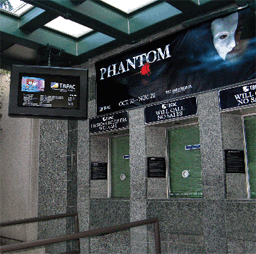
Professional Communications Systems for Tampa Bay Performing Arts Center (TBPAC).
PURPOSE: The project is central to and a key element of the Tampa Bay Performing Arts Center Experience marketing initiative, the goal of which is to garner repeat business and elevate customer satisfaction by providing an unmatched total entertainment experience.
DESCRIPTION: To achieve the client’s objectives, the system installation must supplement an events ambient environment and enhance the experience of more than 800,000 annual visitors and patrons. The intention is to involve and excite the customers using high definition video, programmed music, and on-screen graphics throughout their visit to the Performing Arts Center. The Experience system acts as an aural and visual overture, which sets the mood as patrons are welcomed from parking areas onto exterior approaches via a pedestrian bridge, and continues throughout garden esplanades, in theater lobbies, and reception areas.
A decision was made early in the planning process that the DS system would be used only for branding, marketing of upcoming shows, and sponsorship recognition at the highest levels. The concept behind this choice appears to be a rarity in the traditional retail digital signage market, where the incentive and ROI to purchase a system is often an advertising mechanism that generates revenue from other business’s marketing.
CHALLENGES: Hybrid baseband/IP infrastucture: Maintaining a strict budget without eliminating several desired features presented a challenge that was overcome using both baseband and IP technology. Installing a PC that was HD-capable at each location was cost-prohibitive from both a hardware and software licensing perspective. The trade-off was a reduction in the number of players to six and handling the signal distribution through a matrix switch. This solution actually worked nicely since it allows the Center to send uncompressed video and audio, and control several hundred feet over twisted pair cable. It also became unnecessary to encode the HD cameras to an IP transmission format, further reducing equipment costs.
Infocaster Players and HD cameras in this application can be thought of as independent channels of programming; the AMX controller then schedules the displays and audio to tune in at the appropriate time
RESOURCES: A Harris Infocaster Digital Signage System, consisting of a creation station, network manager, and six AS1000 players, is central to the entire project. The system is integrated with an AMX Netlinx control system, feeding nine video zones equipped with 27 Sharp LCD displays. The system is also integrated with a Symetrix Symnet audio system in the eight audio zones. The primary video zones are Morsani Hall (12 LCD screens) and Ferguson Hall (5 LCD screens) lobbies. Four smaller venues include Shimberg Hall (1 LCD screen), Jaeb Theater (2 LCD screens), the Ticket Office (1 LCD screen), and the Patel Conservatory of Music (2 LCD screens). Equipment includes: Harris Infocaster Digital Messaging, Sharp LCD displays, AMX Control System, Symetrix Symnet audio processing and Tannoy speakers, TOA Electronics, OWI, Middle Atlantic equipment racks, Extron, and Shure. Equipment was selected based on factors of quality, reliability, scalability for future growth, operational flexibility, and exterior durability.
EFFECTIVENESS: Effectiveness is gauged primarily through observation of Performing Arts Center customers’ interest level. This includes observation of customers entering and leaving the facilities and theaters, and their reaction to the video, graphics, and programming being shown on the numerous displays, in addition to audience reaction to music being played throughout the Center’s audio zones. TBPAC considers a project successful when there is good ROI, i.e., it has affected the mood of the customer and contributed to an overall positive customer experience.
PARTNERS: Harris Corporation Broadcast Communications Group, Digital Signage division (www.harris.com); AMX Corporation (control panels); Symetrix, Inc. (Symnet Audio)
ENTRY CONTACT: Professional Communications Systems, Tampa, Fl, www.pcomsys.com
Best Content: Interactive
MONSTER MEDIA FOR OXYGEN NETWORK’S DANCE YOUR A** OFF STOREFRONT
PURPOSE: To create a cutting-edge ad campaign promoting the premiere of the new reality show, Dance Your A** Off on June 29, 2009.
DESCRIPTION: This over-sized outside display was ideally placed just steps from Macy’s and right outside the 34th Street- Herald station at 1333 Broadway. The intended experience of this display was to create buzz around the new weight-loss, dance off reality series on Oxygen and inform viewers of its launch date. This LCD-infused storefront domination campaign was triggered by the body movements of passers-by and featured footage of the contestants. Keeping with Oxygen’s “Live Out Loud” theme, users also activated a full audio aspect, complete with both music from the show and dialog. Oxygen’s nine linked LCD interactive display area was Monster Media’s largest LCD-based window campaign. Proprietary software that Monster developed in-house was run on the display
EFFECTIVENESS: Oxygen measured the effectiveness of this campaign by the number of viewers who tuned into the premier of the show. Oxygen and Monster Media reaped positive results from this collaboration. The campaign not only increased viewer awareness of the show’s premiere, but led to Dance Your A** Off setting a network record when it debuted to an average of 1.3 million total viewers. That’s the largest audience ever for a series premiere on Oxygen.
ENTRY CONTACT: Monster Media, www.monstermediainc.net
Interactive Technology Roll-Out
2C VISUAL COMMUNICATIONS FOR BC CHILDREN’S HOSPITAL
PURPOSE: BC Children’s Hospital Foundation (BCCHF) was seeking a more provocative approach to educating the community about its fundraising campaign, a $200-million initiative to create a legacy for British Columbia’s children. BCCHF developed the idea for an interactive mural that attracts the attention of passersby to encourage donations, profiles key donors, educates the public about the campaign, and keeps everyone up to date on the progress of the new hospital construction and campaign proceeds.
DESCRIPTION: The wall uses a superhero comic-book theme designed to resonate with children and entertain adults. In the lobby of the BC Children’s Hospital, when a passerby comes within reach of sensors strategically placed on the mural, the wall wakes up. At this point, depending on what area of the wall they have encountered, content begins to play on a main screen with instructions on how to interact with the mural.
EFFECTIVENESS: Wanting to step outside the box of traditional community fundraising, BCCHF immediately saw results. Also, the mural has added a distinct level of fun and entertainment to the lobby, so it is common to see kids enjoying the technology. The effectiveness of this digital signage is seen on a daily basis as both children and adults interact with the wall. The hospital staff has reported a strong, positive reception by patients, hospital staff, donors, and the community. The interactive donor wall has also seen its share of local media coverage with interviews conducted directly in front of it, furthering the message about the campaign for BC Children.
RESOURCES: Integrating Scala Content Manager and Scala Designer with 2C Visual Communications diVA was key to keeping the content updating process simple for the Donor Relations team. The final product was a 10- feet tall by 15-feet wide display that features four LCD screens, four audio speakers, two motion sensors, four distance sensors, sound, and lighting. ENTRY CONTACT: 2C Visual Communications,
Best Content: Merchandising
SCHULT FOR REGAL ENTERTAINMENT, DIGITAL MENU BOARDS
PURPOSE: The gaol was to modernize existing concession area menu boards (illuminated) with multi-screen digital menu systems that promote food and beverage offerings at the point-of-sale.
DESCRIPTION: The national roll-out involved 305 Regal Entertainment Group movie theater locations across the country. Schult, operating as integrator, designer, truss manufacturer, and project manager for the roll-out, was required to meet an aggressive timeline across three phases of installs without interrupting concession transactions during the installation. Four thousandplus digital menu boards successfully went “live” for transactions in 10 months start to finish. Schult’s customdesigned truss system cut the installation time on the project by 35 percent, resulting in sizeable labor savings and the acceleration of project completion. The tight roll-out timeframe dictated training up to 12 three-to-four-man teams operating in the field at any time. It was important that the job get done without having to revisit any DMA.
The SOW required taking down, disposal, and replacement of old light boxes with 12-24 digital menu boards per site. Each completed system had a custom-designed wall or suspended truss support across the entirety of the concession area (integrating associated hardware and visual distribution systems to varied manager or network locations within the theater). The existing conditions and site modifications required at each site were unique and mandated the design and coordination of solutions/labor, involving carpentry, tile, trenching, wall and ceiling reinforcement, blocking, cutting of mirrors and glasswork, and paint from beginning to end. Site working hours were limited to nonoperational hours (midnight to 8 am) and required the concession area to be clean and functioning for food transactions each day of the installation. Despite the challenges of geography, timing, management of trades and conditions, teams were able to achieve a three-day installation average per location throughout the 10-month project.
PARTNERS: Christie Digital (Projectors), Sony
ENTRY CONTACT: Schult, www.schult.com
Best Content: Corporate Communications
DIGITAL DISPLAY & COMMUNICATION FOR ROGERS COMMUNICATIONS’ UR MUSIC
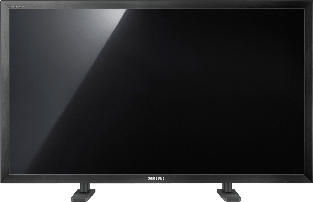
Samsung Electronics America for the Samsung 820TSn Interactive LCD Panel
PURPOSE: This installation/channel, inside over 300 Rogers Plus stores across Canada, is intended to draw the attention of the retail shopper in a Rogers Store and inform them of offers and promotions currently available.
DESCRIPTION: Content on the channel is strictly Rogers content with no outside advertisers. Quarterly promotional offers and featured phones are the focus on this channel. It also maintains brand consistency and look on-screen, adding to the overall store’s cohesiveness. This spot is targeted to the 15-23 year old demographic who are looking for something more from their phone and actively listen to current music. They are savvy cellphone users, and the majority of their use is texting friends. Simple graphic icons representing music were used to ensure the viewer was aware during the entire spot that this specific offer was intended for music-lovers. Current album/DVD covers running along the bottom of the spot were also used to appeal to the targeted demographic and peak interest. Motion was also applied to the UR Music icon to further illustrate the intent and add visual appeal. The spot also maintains a relatively fast pace to keep interest and give the sense of musicality without the music.
CHALLENGES: The primary challenge was to appeal musically to viewers without the use of audio, as this particular channel/installation does not play back audio. DDC overcame this challenge by maintaining a fast pace and adding motion elements such as music notes and volume bars on the URMusic icon to keep the viewer watching and allude to the pace and fun of today’s pop music.
PARTNERS: Software and hardware supplied by ADFLOW networks.
ENTRY CONTACT: Digital Display & Communication, http://thefullpicture.com/
Best Content: Advertising
DIGITAL DISPLAY &COMMUNICATION FOR HYPE CAMPAIGN/ROGERS STORES CANADA
PURPOSE: This installation/channel is intended to draw the attention of the retail shopper in Rogers Stores (over 300 Rogers Plus stores across Canada) and inform them of offers and promotions currently available. Content on the channel is strictly Rogers content with no outside advertisers. Quarterly promotional offers and featured phones are the focus on this channel. It also maintains brand consistency and look onscreen, adding to the overall stores cohesiveness.
DESCRIPTION: The graffiti graphic appeals to this demographic and ensures the phone takes on a younger personality and successfully sends the message that the phone is intended to stand out from the crowd. Lifestyle imagery was used to further support the intended audience and also to maintain consistency of the client’s brand that uses friends and family-focused imagery throughout their store design and other advertising collateral.
CHALLENGES: The primary challenge as an agency is to create cohesiveness with print collateral both in-store and out-ofhome without re-creating/re-purposing the same advertisement. DDC overcame this by focusing on key messaging only and using motion elements on the graffiti to bring it to life and differentiate it from the print pieces, while still maintaining the look and feel. A secondary challenge was budget — DDC could not rely on custom lifestyle video shoots for these spots, so they used stock still imagery to bring it to life.
PARTNERS: Software and hardware supplied by ADFLOW networks.
ENTRY CONTACT: Digital Display & Communication, http://thefullpicture.com/
Best New Technology Innovation in Digital Signage Displays
SAMSUNG 820TSN LCD PANEL
DESCRIPTION: The Samsung 820TSn LCD Panel represents the latest in interactive touchpanel technology. Infrared (IR) technology and 3mm and protective glass means it is built to last in the commercial environment.
- Two integrated high-powered 10W speakers
- 4-way anti-burn-in protection
- Built-in PCs for easy networking
- Proprietary MagicInfo content management software
- 82-inch diagnal size
- Resolution: 1920x1080
- 5000:1 contrast ratio
- PC inputs: VGA/DVI
- Video inputs: CVBS/HDMI
ENTRY CONTACT: Samsung America, www.samsung.com/prodisplay
Best New Generation Display Device: Large Screen
ADEX INTERNATIONAL, DUAL-PROJECTION GLASS WALLED STRUCTURE WITH POLARIZED LCD OVERLAY

ADEX International’s projection glasswalled gate structure with an overlay of polarized LCD film
DESCRIPTION: Customers at NCR Executive Office at 7 World Trade Center are greeted with a dual-projection glasswalled gate structure with an overlay of polarized LCD film. These gates pivot and open silently via RF control, which sequences and separates the message as the presenter walks the customer through the space. The predominant design criteria is meant to engage the customer with an extraordinary, adaptable and very unique application of HD video, NCR brand messaging, and 6.1 Dolby Digital Surround Sound.
The polarized LCD film is unique in its ability to change from a projection screen to clear glass with the touch of a button. Each large glass panel has content driven by two projectors, one projector for the closed position and one projector for the open position. There are eight projectors total for the two sets of gates. The Center showcases the latest in LED lighting and multimedia control, allowing a stark white/grey background to come alive with color and luminance. The LED lighting is very chameleon-like, and can be programmed to change color based on the visitor, season, NCR brand changes, etc. The lighting can be programmed to display one color, rotate between selected colors, or rotate all colors. The same LED light technology is integrated throughout the EBC from the elevator lobby, reception desk, and Solution Center.

MicroSigns Inc. for Integrated, Wireless Display Network and Content Management System
RESOURCES: ADEX was selected to not only design, procure, produce, and install the various elements within the Executive Briefing Center, but are continually engaged with any service matters and are available for any emergency issue. In lieu of DVD players, digital media servers provide all of the HD output for the videos and multimedia content viewed throughout the Solution Center. By using media servers, many of the maintenance and quality problems that come with using DVD players, even on high-end industrial models, were eliminated.
ENTRY CONTACT: ADEX International, www.adex-intl.com
Best New Display Device: Small Screen
MICROSIGNS INTERACTIVE 3.5- INCH COLOR LCD MICROPLAYERS
DESCRIPTION:Microsigns is an integrated, wireless display network and content management system that is specifically designed for mobile phone stores. The MicroSigns Platform consists of interactive 3.5-inch color LCDs called MicroPlayers that replace the paper facttags that are currently used to communicate product, pricing, and promotional information about handsets in mobile phone stores. MicroPlayers are backed by a wireless network and content distribution system that provides tools for planning, creating, scheduling, and positioning content at each handset in mobile phone stores.
The ubiquitous nature of the players (positioned under each handset) provides new communications opportunities between carriers and their customers in stores. The one-touch interactive input on every player enables customers to peruse sales messages about mobile phone products and services at their own pace. The nature of the sales messages is decided centrally by the carrier and typically includes handset features and pricing, as well as accessories, value-added services, and promotions.
ENTRY CONTACT: MicroSigns Inc., www.microsigns.com
Best New Generation Display Device (Non-LCD or Plasma):
GESTURETEK’S PIONEERING, MULTI-PATENTED 3DVISION IMAGE CONTROL SYSTEM FOR SPRINT
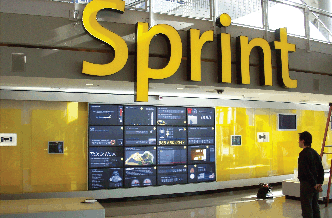
GestureTek for 3D Depth Sensing Interactive Digital Sign with Mobile Phone Interactivity.
DESCRIPTION: GestureTek’s pioneering, multi-patented 3D-vision image control system is a highly precise and reliable gesture-based user interface for interacting with any display screen. Whether on a personal computer, set-top box, television set, mobile device, game console, digital sign, or interactive kiosk, GestureTek’s ground-breaking depth tracking software enables users to control onscreen interaction with simple hand motions instead of a remote control, keyboard, or touchscreen.
Among other applications, GestureTek’s innovative 3D depth sensing technology was selected to power an attention-grabbing interactive digital signage system on behalf of telecom leader Sprint. Sprint’s 3D depth sensing interactive display screen, with mobile phone connectivity, tracks people’s body movements and responds by sending a Sprint promotional message that follows them the entire length of the interactive billboard. The interactive motion-detecting advertising message invites users to create their own personalized interactive wall art on Sprint’s gesture control screen by calling Sprint on their mobile phone. The installation was led by partner Mission Electronics.
3D gesture recognition software allows people to watch their video image or full-body 3D avatar while interacting in real time with computergenerated characters and objects. The system repeatedly and reliably tracks full-body movement and subtle gestures in complete 3D space. Resistant to distractions like background movement or variable lighting, the system locks onto the user and translates their unique movements into specific computer commands and events.
ENTRY CONTACT: GestureTek, www. GestureTek.com
Best New Content Management Software/ Web-based (SaaS)
SIGNCHANNEL, FROM THINKING SCREEN MEDIA
DESCRIPTION: SignChannel is a very easy-to-use, low-cost digital signage subscription service targeted primarily at the small and medium business market. SignChannel users can remotely control the content that is displayed on their “Players” using the SignChannel web service (www.signchannel.com).
With SignChannel you can manage multiple Players from one account with different content sets flowing automatically to different Players. That content can be the users’ own uploaded photos (or videos on devices that support video), or slides that are created through our template-based slide generation tool (powered by Scala), along with content from our 1000 channels of local news, weather, sports, stock quotes, and more. SignChannel’s intuitive user interface plus the users’ ability to simply create their own signage and organize a vast array of public content make it the ideal self-service digital signage service. Costs for set up and ownership are very low because there is no software to buy, there is no training required, display devices are inexpensive, and content can be developed without professional design help and the service can be implemented and supported without computer technicians. The user simply logs in to their SignChannel account, selects their content and display preferences, and their slideshows will update automatically.
ENTRY CONTACT: Thinking Screen Media, www.thinkingscreen.com
Best New Content Management Software/Premise-Based
OMNIVEX MOXIE
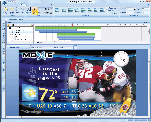
Moxie, from Omnivex, is a new software suite for “Contextual Communication.”
DESCRIPTION: Omnivex Moxie is a new software suite developed to manage enterprise-level digital signage networks, allowing digital signage to not only convey multiple pieces of information, but relative value between that information. This kind of “Contextual Communication” is critical to every business, and Moxie provides the software tools to deliver messages to their intended audience at the most effective time.
Moxie software is able to determine what to present on the screen based on internal and external information, saving hours of reworking/content creation time, eliminating redistribution costs, and providing instant updates to increase the effectiveness of your messages. Any parameter such as size, position, opacity, and color can be tied to real-time data so information can appear and change based on current events.
Moxie introduces true 3-D graphics to the realm of digital signage. With Moxie your graphics can scale to fit each screen resolution and are rendered in real time with any aspect of the content able to change on the fly.
Moxie takes advantage of Microsoft’s new WPF technology to allow users to create multiple graphic layers on non-rectangular surfaces, and group, rotate, and orient them as desired, all with true 3-D graphics capabilities. The use of metadata to tag assets (content and players) is utilized by several suppliers to manage inventory, but Moxie goes well beyond that by allowing the system to make intelligent decisions based on this information.
ENTRY CONTACT: Omnivex Corporation, www.omnivex.com
Best New Audience Measurement Package:
COGNOVISION SOLUTIONS INC. FOR ANONYMOUS IMPRESSION METRIC (AIM)
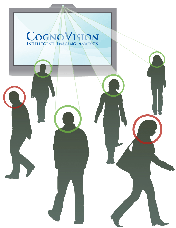
DESCRIPTION: CognoVision’s AIM audience measurement and retail intelligence platform includes proximity people counting, face detection, anonymous demographic profiling, traffic flow heat mapping, and queue tracking. The solution offers both audience measurement and retail intelligence metrics as parts of a cohesive whole, offering unparalleled, actionable intelligence to digital signage network operators, advertisers, content producers, and location providers (such as retailers). By using commodity cameras (i.e., low-cost webcams and security cameras) and standard computer systems, the system can be deployed on a large scale without a heavy capital expenditure.
AIM has been integrated with digital signage technologies provided by many major display and media management software providers, including BroadSign, Capital Networks, and DynaSign, among a growing list of major partners. One of many unique features is Campaign Analytics — CognoVision’s OVAB-consistent AIM Analytics online reporting system pioneered fully automated campaign analytics, which offer digital signage networks the capability to automatically receive campaign-specific audience metrics. This offers the capability to understand metrics for specific content pieces — i.e., how many people saw the advertisement for company A vs. company B. This integration was first completed with the BroadSign platform, and is currently being completed with several leading digital signage software providers. This has been deployed in The Marketplace Station digital signage network in select Whole Foods locations in Canada and the U.S.
ENTRY CONTACT: CognoVision, www.CognoVision.com
Judges Choice Award
WALT DISNEY WORLD FOR THEIR DIGITAL GUEST COMMUNICATIONS
PURPOSE: Replacement of traditional printed menu boards in food and beverage locations in theme parks and resorts with digital signage.
DESCRIPTION: All content is to be driven by information mined from terrabytes of data, using patron influences such as RF Cameras and iPhones to manipulate content in real time interaction with cast and guests. One example is found at Cosmic Ray’s in the Magic Kingdom. A manager can notice a guest, approach them, and find out what they happen to be celebrating on their trip. A quick snapshot and a couple taps on the phone later, the guest’s image is displayed on the sign incorporated into the normal flow of the content. The use of specially targeted information has seen an easily demonstrated lift of over 100 percent year-overyear sales on the specific item tested. When the test is reversed, the item returns to pre-test levels.
CHALLENGES: The extreme level of theming found in Disney parks and resorts is always challenging. How do you make a digital sign not look like a digital sign in the old west? Many hours of creativity were put in to solving for many differing scenarios. This project was the culmination of almost 10 years of research, starting with designing digital signage software in house in 1998 up to today, and Disney has chosen the Harris Infocaster product to deploy in all of their parks and resorts.
ENTRY CONTRACT: Walt Disney World, www.disneyworld.disney.go.com
